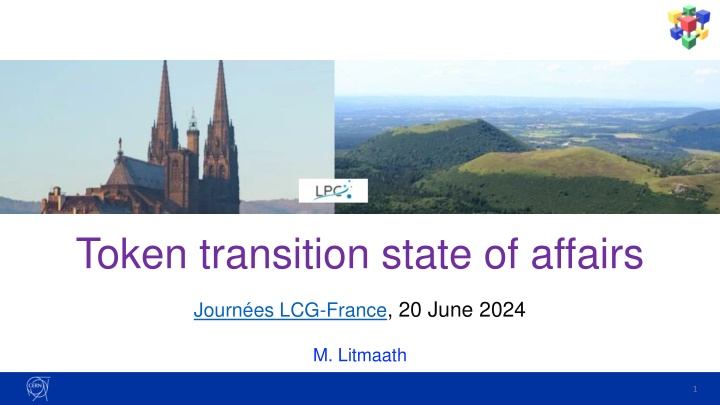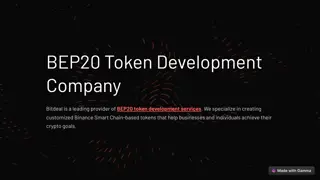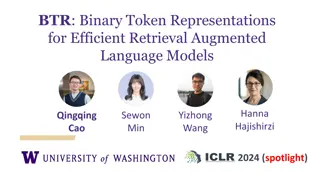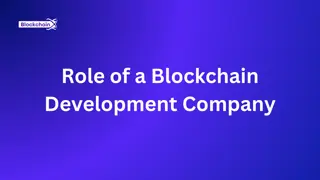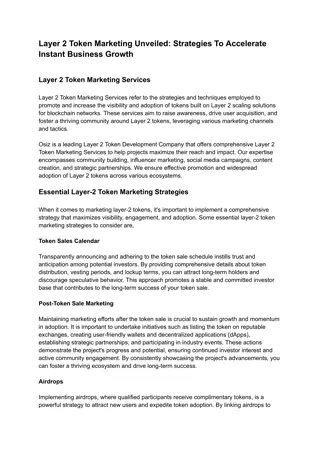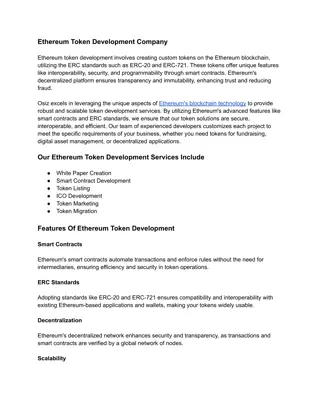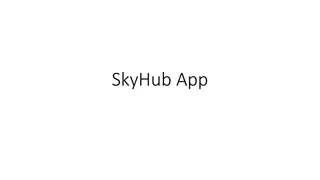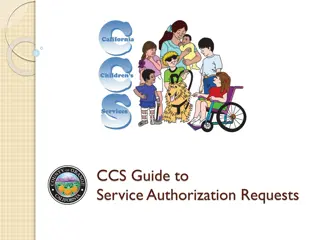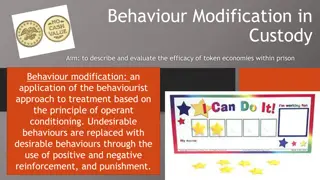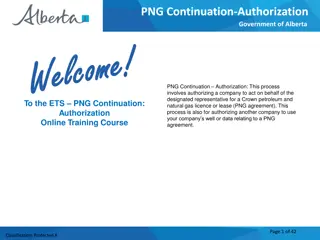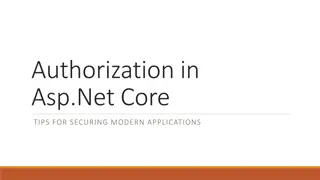Transition to Token-Based Authorization
Over the past 20 years, WLCG users have relied on X509 certificates for authentication. Now, moving towards token-based authorization offers improved security, fine-grained access controls, and simplifies workflows.
Download Presentation

Please find below an Image/Link to download the presentation.
The content on the website is provided AS IS for your information and personal use only. It may not be sold, licensed, or shared on other websites without obtaining consent from the author.If you encounter any issues during the download, it is possible that the publisher has removed the file from their server.
You are allowed to download the files provided on this website for personal or commercial use, subject to the condition that they are used lawfully. All files are the property of their respective owners.
The content on the website is provided AS IS for your information and personal use only. It may not be sold, licensed, or shared on other websites without obtaining consent from the author.
E N D
Presentation Transcript
Token transition state of affairs Journ es LCG-France, 20 June 2024 M. Litmaath 1
Background (1) Since 20 years, WLCG users have been using X509 certificates to identify themselves to grid services Certificate lifetimes are up to 400 days It is not sufficient for users to able to identify themselves: there must also be a way for grid services to know to which virtual organization (VO) a user belongs E.g. which LHC experiment For that purpose we have been using a Virtual Organization Membership Service (VOMS) for each VO that we need to manage In particular the LHC experiments The membership of each VOMS instance can be queried by grid services, but most grid services do not need to do that anymore, as is explained on the next pages Such queries are done against VOMS-Admin endpoints 2
Background (2) Only in browsers are user certificates used directly For most grid workflows, short-lived proxy certificates ( proxies ) are used that are derived from long-lived (proxy or real) certificates To limit the risk of theft of long-lived credentials and their potential abuse Per workflow, such proxies can be equipped with additional attributes indicating to which VO the user belongs, to which groups within the VO, and which of their allowed roles the user is assuming for the given workflow Such attributes are captured in an attribute certificate that is obtained from the VOMS service of the VO and then embedded in the proxy that the user will use: a VOMS proxy VOMS-aware services will normally bestow client requests with privileges based on the contents of those attribute certificates 3
Why change? While the previously described machinery has done the job for 20 years, there are several aspects that we do not like: User certificates are cumbersome I got a new certificate and nothing works anymore: help! Proxy certificates are used only in grid workflows, not in industry We thus need to maintain our own certificate handling stacks VOMS attributes are still rather coarse-grained A stolen VOMS proxy could still open the door to significant abuse 4
The solution: move to tokens Standard practice in industry and academia Used under the hood users do not have to know about the details! Fine-grained access controls improved security Capabilities a.k.a. scopes Which operations are allowed Can be set for individual files as needed Audiences Which services should accept a given token The price to pay: decide per operation which token to use! Complicating middleware and workflows 5
Token example $ ls -l tmp-$$.dat -rw------- 1 alicesgm alicesgm 881 May 25 15:57 tmp-3140407.dat $ decode-token.sh tmp-$$.dat { "wlcg.ver": "1.0", "sub": "a4f952ab-6e43-059c-c530-80df119a018b", "aud": [ "ce01.some.site:9619", "ce02.some.site:9619" ], "nbf": 1716645428, "scope": "compute.create compute.read compute.cancel compute.modify", "iss": "https://alice-auth.web.cern.ch/", "exp": 1716991028, "iat": 1716645428, "jti": "852f012c-5bcb-4a9c-a2e6-ec2e25801560", "client_id": "ae76ab27-cc15-4082-a9bc-50ad587a73d6" } $ 6
CERN SSO CERN groups X.509 IAM = Identity & Access Management New AAI architecture for WLCG Import of existing memberships & credentials WLCG IAM This is the service that will be gone! VOMS VOMS backwards compatibility endpoint Membership management & Credential store Integration with identity vetting & affiliation dates HR DB Crucial legacy functionality remains supported for now Tokens are used here WLCG Legacy Service (X.509) WLCG Service (OIDC) 7
WLCG Token Transition Timeline Since July 2017, the WLCG Authorization WG has been working on the design and implementation of the new AAI architecture for WLCG A token transition timeline with tentative milestones was published on August 22, 2022 Though most milestones were postponed for several reasons, progress has been steady Details about various aspects are provided on the next pages 8
Computing (1) Campaign to have HTCondor CEs upgraded to maintained versions Intermediary version: v9.0.20 Supports tokens, SSL (no VOMS mapping) and GSI (with VOMS mapping) Versions >= v23.x Support tokens and SSL without VOMS mapping Versions >= v23.5.2 Support tokens and SSL with VOMS mapping! (release notes) To use SSL mappings with proxies, clients must also run recent versions! All versions support delegation of VOMS proxies to be used by jobs and APEL Mind this HTCondor (CE) setting for APEL: USE_VOMS_ATTRIBUTES = True 53 tickets, >= 18 solved Many sites prefer upgrading to EL9 at the same time APEL client, parsers and python-argo-ams-library available from the WLCG repository 9
Computing (2) APEL support for tokens is discussed separately between concerned parties APEL, HTCondor, ARC, several sites, EGI Ops, WLCG Ops Coordination Stopgap approaches are proposed for the time being Map token issuers / subjects / to pseudo VOMS FQANs The rest of the machinery can stay unchanged Medium-term solution expected from the GUT Profile WG (see later) 10
IAM service developments (1) All production instances at CERN are on a v1.9.0 pre-release since June 13 (to be updated next week) Fixing various high-priority issues in the area of VO management Other fixes are still expected in a few weeks The dteam instance is usable for service monitoring with tokens Users are imported from the VOMS-Admin service until its retirement VO membership is managed by EGI Operations and WLCG Ops Coordination A campaign has been launched on April 19 for sites to configure support for the instance for the ops VO by June 1st 156 tickets, >= 140 solved 11
IAM service developments (2) New instances for the LHC experiments have been created on Kubernetes, sharing their DBs with the OpenShift instances For better load-balancing, logging, monitoring, GitOps and HA options They will eventually replace the current production instances on OpenShift Dates to be decided per experiment Sites have been ticketed to add support for the future VOMS endpoints and token issuers by May 31st Many tickets are still open A timeline with tentative milestones for the transition from VOMS-Admin to full dependence on IAM was agreed for the LHC experiments ATLAS and ALICE have migrated, LHCb look ready for June 24, CMS still WIP Supported use cases for the time being are: VO management VOMS proxies Low-rate token issuance for pilot jobs, SAM tests etc. 12
Why is the VOMS-Admin phaseout happening now? The VOMS(-Admin) service was expected to be unsupported beyond CentOS 7 Packages are available for EL8 and EL9, but not fully tested And incompatible with MySQL 8 The developers at CNAF cannot afford to keep maintaining two VO management solutions The CentOS 7 EOL thus became the VOMS(-Admin) EOL June 30, 2024 However, limited support beyond CentOS 7 has been obtained by EGI as announced through a broadcast on June 19 Further details in this section of the June 10 EGI ops meeting notes 13
VOMS-Admin phaseout snapshot April 29 Remove legacy VOMS servers from vomses in production for Puppet at CERN as of May 7 Many tickets from users who were disabled in IAM due to sync issues, all fixed manually Versions 2.0.0 of the wlcg-voms rpms only contain the LSC files, no vomses files Broadcast sent to wlcg-operations list Not critical: voms-proxy-init would fail over to a VOMS server that works May 06 VOMS-Admin switched off for first VO delayed until after the WLCG workshop No VOMS-Admin service is deleted yet May 31 Deadline for sites to have configured support for the Kubernetes instances, including ops Start considering switching off OpenShift instances unlikely to happen before July September Possibly depending on HA situation on Kubernetes Ultimately also the oidc-agent menu listing IAM instances should be updated accordingly June 03 VOMS-Admin switched off for last VO was in fact the first VO: ATLAS ! 14
Data Challenge 2024 (1) DC24 was a major milestone in the WLCG Token Transition Timeline It has allowed scale tests with tokens of services involved in data management Rucio (ATLAS & CMS) and DIRAC (LHCb) FTS IAM ALICE use access envelope tokens with XRootD services since 20 years, but a future switch to WLCG tokens is an option being worked on! The Data Challenge sessions of the WLCG workshop also feature observations and discussions about the use of tokens 15
Data Challenge 2024 (2) DC24 has allowed us to draw conclusions from millions of transfers done with tokens! It is clear that some ways in which tokens were used are not advisable for the long term FTS and IAM instances got overloaded in various ways, causing failures and requiring interventions Several ideas for more sustainable use of tokens will be discussed in the next months between experts of the services involved Concerning token audiences, scopes, lifetimes, exchanges, refreshing, ... For the time being, we keep relying on VOMS proxies for most of our data management 16
AuthZ WG items (1) Various IAM code changes were desirable in the short term In particular to fix VO management issues in view of VOMS-Admin EOL They were the main focus of an IAM Hackathon at CNAF, May 29-30 Lessons learned from DC24 will be taken into account later In particular, stop storing access tokens in the DB No high-rate usage is foreseen for the time being First, sustainable token usage patterns have to be agreed and tested between the parties involved in data management Version 2.0 of the WLCG token profile is under preparation Fixing a number of issues encountered with v1.0 In the description and/or implementation Most PRs have been merged and the corresponding issues closed A few open cases need to be discussed in AuthZ or DOMA BDT WG meetings More difficult cases will be postponed for future revisions 17
AuthZ WG items (2) The Grand Unified Token (GUT) Profile WG has met 5 times already (agendas) Good progress with its current main challenge: how to determine the VO for the token profiles and the various use cases we need to handle WLCG tokens, SciTokens, EGI Check-in tokens A new, common attribute will be defined with practical semantics Details TBD in upcoming meetings The Token Trust & Traceability WG will meet again June 25 Aiming to equip site admins, VO experts, with best practices for tokens, which will also provide input for policy documents Recipes, tools, log mining, testing, debugging, monitoring, banning, ... For example, to prevent exposure of tokens through logs! Or how to use the dteam VO for monitoring with tokens (see next page) 18
Auxiliary services The March 7 Ops Coordination meeting had a presentation on MyToken Used at KIT e.g. to monitor dCache services with dteam tokens Further details are available here The May 2 Ops Coordination meeting had a presentation on htgettoken + HashiCorp Vault as a Service for Managing Grid Tokens In production at FNAL for various communities since >1 year Such auxiliary services are expected to facilitate various use cases Production workflows Monitoring User workflows To help avoid that users need to know anything about tokens! 19
Conclusions and outlook Collaborative efforts will involve many of us in the next months VOMS-Admin EOL planned deadline for CERN VOs June 30 IAM usability for VO administration by LHC experiments and others Work on high-priority issues continuing for a 1.9.x release in July HA options for LHC experiment IAM instances advancing Data management: lessons learned from DC24 Aiming to reach the next level of token usage in the second half of this year HTCondor CE versions that no longer support GSI along with moving to EL9 APEL adjustments for tokens short vs. medium term GUT Profile WG progress toward a new VO attribute for accounting and more Version 2.0 of the WLCG token profile to signal where we intend to go More deployment and operations know-how also providing input for policies More use of auxiliary services gradually benefiting more use cases Thanks for your kind attention! 20
